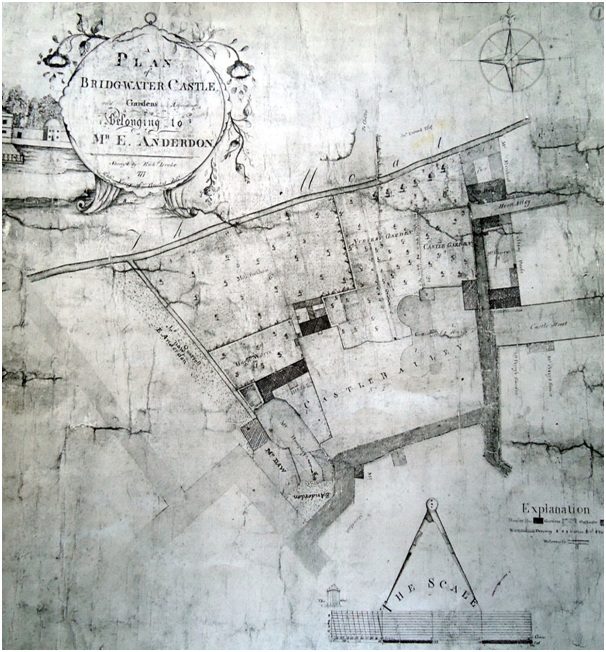Bridgwater Castle on:
[Wikipedia]
[Google]
[Amazon]
Bridgwater Castle was a castle in the town of Bridgwater,
 Bridgwater Castle was a substantial structure built in
Bridgwater Castle was a substantial structure built in
Somerset
( en, All The People of Somerset)
, locator_map =
, coordinates =
, region = South West England
, established_date = Ancient
, established_by =
, preceded_by =
, origin =
, lord_lieutenant_office =Lord Lieutenant of Somerset
, lord_ ...
, England.
The stone castle was built around 1220 and contributed to the development of the town. It was surrounded by a moat and included a watergate giving access to the quay. In the 13th and 14th centuries the castle was involved in the Second Barons' War
The Second Barons' War (1264–1267) was a civil war in England between the forces of a number of barons led by Simon de Montfort against the royalist forces of King Henry III, led initially by the king himself and later by his son, the fu ...
and Despenser War
The Despenser War (1321–22) was a baronial revolt against Edward II of England led by the Marcher Lords Roger Mortimer and Humphrey de Bohun. The rebellion was fuelled by opposition to Hugh Despenser the Younger, the royal favourite.Some his ...
.
It then fell into ruin and parts were demolished in the first half of the 17th century and a new house built. Some of the walls survived and it played a minor role in the English Civil War
The English Civil War (1642–1651) was a series of civil wars and political machinations between Parliamentarians (" Roundheads") and Royalists led by Charles I ("Cavaliers"), mainly over the manner of England's governance and issues of re ...
and Monmouth Rebellion. In the later 17th and early 18th centuries many of the remaining buildings were demolished and new residential and industrial buildings constructed, giving its name to Castle Street. The watergate and some sections of wall survive.
Early history
The castle was built early in the 13th century by William Brewer, like several other castle-builders of the period, an exceptionally wealthy man. He was granted thelordship
A lordship is a territory held by a lord. It was a landed estate that served as the lowest administrative and judicial unit in rural areas. It originated as a unit under the feudal system during the Middle Ages. In a lordship, the functions of econ ...
of the Manor of Bridgwater by King John in 1201, and founded Bridgwater Friary
Bridgwater Friary was a Franciscan monastery in Bridgwater, Somerset, England, established in 1245 and dissolved in 1538.
It was founded by William Briwere and moved from another location. Further buildings were added in 1278 and 1284. The chur ...
. Before the building of the castle, Bridgwater was much smaller, but after the granting a licence to crenellate
In medieval England, Wales and the Channel Islands a licence to crenellate (or licence to fortify) granted the holder permission to fortify his property. Such licences were granted by the king, and by the rulers of the counties palatine within th ...
by King John, in 1200, charters for the creation of a borough
A borough is an administrative division in various English-speaking countries. In principle, the term ''borough'' designates a self-governing walled town, although in practice, official use of the term varies widely.
History
In the Middle A ...
and a market rapidly followed, effectively creating the heart of a new town. Initially Bridgwater faced competition from the established nearby port of Downend, protected by Down End Castle, but the new settlement rapidly became dominant.
 Bridgwater Castle was a substantial structure built in
Bridgwater Castle was a substantial structure built in Old Red Sandstone
The Old Red Sandstone is an assemblage of rocks in the North Atlantic region largely of Devonian age. It extends in the east across Great Britain, Ireland and Norway, and in the west along the northeastern seaboard of North America. It also exte ...
from Wembdon
Wembdon is a semi-rural village near Bridgwater, in Somerset, England.
Wembdon is now home to an Anglican church, a small shop (combined with the post office), a pub and a small garage.
History
Wembdon was listed in the Domesday Book of 1086 a ...
with other stone being transported from Downend in the Polden Hills and Ham Hill by boat. The site covered 8 or 9 acres (32,000 to 36,000 m²). A tidal moat, up to wide in places, flowed about along the current streets of Fore Street and Castle Moat, and between Northgate and Chandos Street. The moat was filled from Durleigh brook, a tributary of the River Parrett. There is some evidence that there was a weir between the moat and the river. Unusually, the main entrance opposite the Cornhill was built with a pair of adjacent gates and drawbridges. In addition to a keep, located at the south-east corner of what is now King Square, documents show that the complex included a dungeon
A dungeon is a room or cell in which prisoners are held, especially underground. Dungeons are generally associated with medieval castles, though their association with torture probably belongs more to the Renaissance period. An oubliette (from ...
, chapel, stables and a bell tower. Built on the only raised ground in the town, the castle controlled the crossing of the town bridge. There is documentary evidence describing the castle as having "outer
{{Short pages monitor